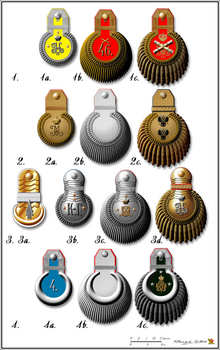Epaulette

Row 1. Infantry version
1a. Senior officer rank group ; Here poruchik His Majesty the Erevan 13. Life Guards Grenadier Regiment
1b. Rank group staff officer ; here Colonel 46th Artillery
Brigade 1c. Rank group generality ; Here General Field Marshal His Majesty ( Wilhelm II., King of Prussia ) Wüborger 85th Infantry Regiment,
2nd Guard version
2a. Senior officer rank group ; here Captain Michailower Artillery School
2b. Rank group staff officer ; here Colonel
Litowsk Life Guard Regiment 2nd rank group flag officer ; here vice admiral
row 3. Cavalry version
3a. Rank Group sergeant ; Here sergeant major of His Majesty Aleksander III Smolensker 3rd Ulan Regiment
3b. Senior officer rank group ; here Podesaul Kisljar-Grebensker 1st Cavalry Regiment of the Tersko Cossacks
3c. Rank group staff officer ; Here lieutenant colonel His Majesty - Her Majesty Marie Fyodorovna Pskovsk 2nd Life Guard Dragoon Regiment
3d. Rank group generality ; here cavalry general, adjutant general of the emperor
row 4. Other versions
4a. Senior officer rank group ; here titular advisor , veterinarian
4b. Rank group staff officer ; here flagship engineer-technician , engineer-technical corps of the fleet
4c. Rank group generality ; Privy Councilor , here Professor Imperial Military Medical Academy
An epaulette (French épaulette , to épaule "shoulder") is a shoulder piece of a uniform . In German this is usually used to describe a special shape that differs from the simple " shoulder flap ". These epaulettes in the narrower sense consist of the crescent moons , the field , the slide and usually also caterpillars or fringes . They are held in place by a shoulder button and a passer-by, which is a transverse stripe of colored cloth or braid on the shoulder through which the epaulette is pushed.
history
Originally the epaulettes were used as shoulder protection against saber blows , but also prevented the shoulder straps from slipping off. In the 19th century, epaulettes were used in many countries (Austria was an exception) as a badge of rank for officers , but they also became part of the gala uniform of some higher civil servants. In most armies the generals wore full epaulettes with thick caterpillars (rigid cantilles ), the staff officers with thin fringes (loose cantilles). The subaltern officers' counter-paulettes had no fringes. In the French army, various guards and elite troops wore epaulettes made of wool (some troops to this day). Under Napoleonic influence, this temporarily prevailed in some states of the Rhine Confederation and other allies of France. In Prussia only the Uhlan crews wore epaulettes similar to the officer's epaulettes; in the other German states this was adopted during the 19th century. The officers of the German and Russian armies wore shoulder boards in the field . The officers of the German navy also wore epaulettes with their large uniforms until 1939.
present

In France , the teams of the Foreign Legion wear cloth paulettes. Today epaulettes are also used in fashion to emphasize the shoulder.
Others
In chess there is the epaulette mate . Here, the king's own figures stand on both “shoulder sides” and block escape areas .
Individual evidence
- ↑ Eberhart Hettler: Uniforms of the German Wehrmacht, Berlin 1939, p. 75 f
